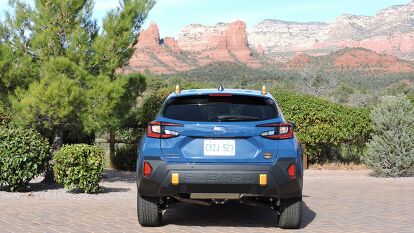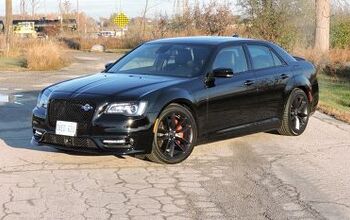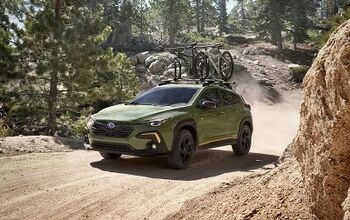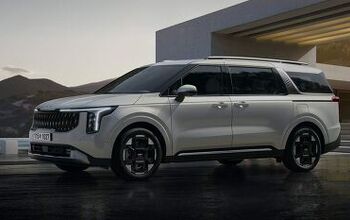2024 Subaru Crosstrek Wilderness Review: Overlanding With a Warranty


LOVE IT | LEAVE IT |
|---|---|
Improved Off-Road Capability | Fuel Economy |
Comfortable Interior | Over the Top Exterior |
Still Drives Like a Crosstrek | Pricing |
Subaru is a company that always seems to find a niche. Twenty years ago, everything the brand made had a bit of rally racing baked in. But sadly, times have changed and so have consumer tastes. Crossovers and SUVs are all the rage now, especially those that are ruggedized and exude an active lifestyle. Subaru has jumped right in on this trend, finding a new sub-market with the Wilderness line of vehicles.
For those unfamiliar with these models, Wilderness is the term Subaru uses to designate the more off-road capable versions of the brand’s SUVs. Already on the market is the Forester Wilderness and Outback Wilderness. Now those vehicles welcome a third member to the family, the Crosstrek Wilderness.
More than Looks
Subaru is not unique in creating brawnier versions of the company’s SUVs. As mentioned, it’s a trend sweeping the industry right now. But unlike a lot of competitors, Subaru is doing more than just slapping on some badges and knobby tires.
For starters, many of the dimensions of the Wilderness are different from regular Crosstrek models. The wheelbase is 0.2-inches (5 mm) shorter, while the track is 0.3-inches (5 mm) narrower up front and 0.4-inches (10 mm) narrower in the rear. The vehicle sits higher, at 63.6-inches (1,615 mm), thanks to increased ground clearance. Overall width is also larger, at 71.7-inches (1,820 mm), due to the extra body-cladding all around.

The front and rear bumpers have been remoulded to provide better off-road angles, and feature copper painted covers on the recovery points. More copper accents are found on the roof rail supports, which we find to be a bit much. Both the front grille design and multi-LED fog lights are unique for the Wilderness. The 17-inch wheels are all black, which is a refreshing change from the various two-tone alloys worn on basically every other Crosstrek.
Of course, Subaru wants casual onlookers to know this vehicle is something different. There are giant Crosstrek badges on the doors, a matte black decal on the hood, eight Wilderness badges, and the word Subaru engraved across the entire rear bumper. Subtle this vehicle is not, especially painted in the Wilderness-exclusive Geyser Blue.
Function Still Reigns

Inside there’s more copper accents, notably with the stitching and lower portion of the steering wheel. The two-tone seats are all-weather soft-touch and contain Wilderness logos on the headrest. The floor mats have yet more Wilderness logos and the gauges in front of the driver are unique.
Not much else is changed inside the Crosstrek, and that’s a good thing. The vehicle has always been one of the more spacious, comfortable, easy to operate SUVs in the segment, so it’s nice none of that is lost in the Wilderness-ification of the vehicle. The step-in height is a bit higher though thanks to the bump in ride height, but not dramatically different.
We like the comfort provided by the synthetic seats and sight-lines remain as good as always. Another unexpected positive is Subaru’s restraint with the copper accents inside. Some previous adventure-lifestyle trims from the manufacturer have been over the top with contrasting painted bits and pieces. That’s not the case here.
Enhancing Capabilities

As mentioned earlier, ground clearance is up 0.6-inches (15 mm). The Crosstrek already had one of the highest ride heights in the segment, but with 9.3-inches (220 mm) of clearance, it can go places many competitors would get high-sided. This added height, along with those unique bumpers, increase the approach angle to 20-degrees, the departure angle to 33-degrees, and the breakover angle to 21.1-degrees.
Despite the added height, the Wilderness’s suspension layout is very similar to regular Crosstrek’s with Macpherson struts up front and double wishbones in the rear. Officially, Subaru does claim it has off-road tuning, which mainly covers the increased ride height and stiffer springs.
Perhaps the biggest improvement towards the SUV’s off-road capability is the addition of Yokohama Geolandar all-terrain tires. Better suited for treacherous terrain, the 225/60R17 tires should help owners plow through tough obstacles. Not as impressive is the narrow, thin front skid plate that won’t really protect much of anything.
Differences Big and Small

On the road, the Wilderness performs much like its less off-road focused siblings. Steering response, turn-in, and cornering capabilities and very similar to the Crosstrek Limited. We’re sure there’s ultimately less grip due to the all-terrain tires, but driven the way the vast majority of Crosstrek owners will, it’s negligible. Those aggressive tires do make more road noise though, but it’s more of a gentle hum than an intrusive drumming.
Off-road, the Wilderness is as advertised. Being a family-focused, affordable compact SUV first, even this Crosstrek isn’t going to traverse rugged terrain like a Jeep Wrangler Rubicon or Land Rover Defender. It bumps, crashes, and thumps its way over rough trails, with less rebound than purpose built off-roaders. But successfully navigate through those trails it does.
The most noticeable advantage to the Crosstrek is the ground clearance. During some level 3 trail riding, we would regularly drive over obstacles we were certain would scrape the under belly. But that was never the case. It builds confidence, and with the A/T tires working in conjunction with the dual-mode X-mode, the vehicle climbs in and out of ruts and gullies with relative ease. We surprised many a side-by-side ATV and home-built rock-crawler during our off-road excursion.
What Hasn’t Changed

Under the hood, things remain very familiar. The Wilderness uses the same 2.5-liter four-cylinder engine making the same 182 hp and 178 lb-ft of torque as found in other Crosstrek models. The only transmission available is a CVT, but the Wilderness does add an oil cooler.
Despite a slight increase in weight, acceleration is very similar to other 2.5-liter equipped trims. It's brisk, if not a bit coarse and droning. We wish the Wilderness came with a version of Subaru’s 2.4-liter turbocharged engine. This would be the perfect Crosstrek to put it in and further increase performance. We understand the hesitation though, as pricing would probably get astronomical for the segment.

With the higher ride height, heaviest curb weight, and the knobby all-terrain tires, the Wilderness is the thirstiest Crosstrek model. It’s rated to get 25 mpg in the city, and 29 mpg on the highway. Compared to the Limited trim, that’s a decrease of 1 mpg city and 4 mpg highway. For Canadian readers, that’s a fuel economy rating of 9.4 L/100 km city and 8.1 L/100 km highway.
A nice side-effect of the Crosstrek going all Wilderness is towing capacity. This little SUV is officially rated to drag upwards of 3,500 pounds (1,588 kg), which is a 2,000 pound (908 kg) increase over the regular Crosstrek. In fact, it ties for the second highest tow rating in all of the Subaru line-up and out muscles nearly all its competitors.
The Verdict: 2024 Subaru Crosstrek Wilderness

In the United States, the 2024 Crosstrek Wilderness starts at a price of $33,540 including destination charges. Add the Harman Kardon sound system, power driver seat, and moonroof package and pricing bumps up to $35,810. In Canada the Wilderness only comes one way, which is fully loaded at a price of $40,190, once again including destination charges.
This lands the Wilderness at the higher end of the pricing structure both within the Crosstrek family and the segment as a whole. The Limited trim, with more features and better fuel efficiency, would make more sense for most consumers. But those willing to pay the premium, that plan to do some moderate off-roading or want the look and feel of the Wilderness, it’s a solid offering on an already well executed vehicle.
Become an AutoGuide insider. Get the latest from the automotive world first by subscribing to our newsletter here.
Fast Facts | |
|---|---|
Engine: | 2.5-liter four-cylinder |
Output: | 182 hp, 178 lb-ft |
Transmission: | CVT |
Fuel Economy (mpg): | 25 city, 29 highway |
Fuel Economy (L/100 km): | 9.4 city, 8.1 highway |
Starting Price (USD): | $33,540 (incl dest) |
As Tested Price (USD): | $35,810 (incl dest) |
Starting Price (CAD): | $40,190 (incl dest) |
As Tested Price (CAD): | $40,190 (incl dest) |

A 20+ year industry veteran, Mike rejoins the AutoGuide team as the Managing Editor. He started his career at a young age working at dealerships, car rentals, and used car advertisers. He then found his true passion, automotive writing. After contributing to multiple websites for several years, he spent the next six years working at the head office of an automotive OEM, before returning back to the field he loves. He is a member of the Automobile Journalists Association of Canada (AJAC), and Midwest Automotive Media Association (MAMA). He's the recipient of a feature writing of the year award and multiple video of the year awards.
More by Mike Schlee



























































































































Comments
Join the conversation
Having had a string of Subarus for over a decade, I kind of always miss them now, but apparently they don't care to have me back in the family... The Crosstrek Wilderness sounds close to perfect for me. However, automatic is bad enough, a CVT is a Hell No. If I am going to be stuck in an automatic it needs a have a lot more grunt than 184hp. So Subaru needs an STi option or a manual, better yet give us both!
Otherwise this is just another boring sport cute POS.
Besides needing more power and different transmission, they really, really must lose all the UGLY plastic cladding. But nice looking otherwise...